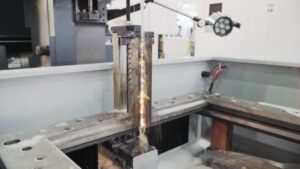Choosing the right Wire Electrical Discharge Machining (EDM) machine is a critical decision that can significantly influence the precision and efficiency of your manufacturing operations. With a vast array of models and features available, understanding which machine best suits your needs can be challenging.
Moreover, the correct choice can enhance production quality, reduce operational costs, and expand your manufacturing capabilities. This guide explores the key factors to consider when choosing a Wire EDM machine, helping you make an informed decision that aligns with your specific requirements and industry standards.
What Is Wire EDM?
Wire Electrical Discharge Machining (EDM) is a precise machining process that uses electrical discharges or sparks to cut materials. Unlike conventional machining methods that use cutting tools, Wire EDM employs a thin, electrically charged wire to erode material precisely. This process is highly effective for creating intricate shapes, fine details, and complex geometries in rigid materials such as metals and conductive ceramics.
How Does Wire EDM Work?

wire EDM machine cutting a die part
Wire EDM operates by generating a series of electrical sparks between the wire and the workpiece. These sparks produce intense localized heat, which melts and vaporizes the material in a controlled manner. Typically made of brass, copper, or tungsten, the wire diameter ranges from 0.1 mm to 0.3 mm, though manufacturers also use finer wires for more precise applications. The wire is continuously fed from a spool and guided along the desired cutting path by CNC. control.
The wire itself does not make physical contact with the workpiece, thus minimizing mechanical stress and deformation. The process is carried out in a dielectric fluid, typically deionized water, which helps cool the workpiece, flush away eroded particles, and stabilize the cutting environment. The Electrical Discharge Generator controls the electrical parameters, including voltage, current, and pulse duration, which determine the intensity and frequency of the sparks.
Applications of Wire EDM
Wire EDM is widely used in industries such as aerospace, medical devices, automotive, and tool and die manufacturing, where precision and complexity remain pivotal.
Specific applications include:
– Aerospace: Aeronautical engineers apply Wire EDM machines in cutting turbine blades, fuel system components, and structural parts with tight tolerances and complex geometries.
– Medical Devices: Medical engineers use Wire EDM machines to manufacture surgical instruments, implants, and micro-scale components that require high precision and biocompatibility.
– Automotive: Automakers utilize Wire EDM machines to produce precision components such as fuel injectors, transmission parts, and engine components that demand high accuracy and durability.
– Tool and Die: Wire EDM machines also apply in creating molds, dies, and intricate tooling components that require precise dimensions and fine surface finishes.
Key Factors to Choose a Wire EDM Machine
Selecting the right Wire EDM machine involves careful consideration of several key factors. Each factor plays a crucial role in ensuring that the machine meets your specific needs and provides the precision, efficiency, and capabilities required for your applications.
Check the vital factors to consider when choosing a Wire EDM machine below:
Machine Precision and Accuracy
When evaluating a machine, consider its ability to achieve tight tolerances. Modern Wire EDM machines can achieve positional accuracies within ±1 µm, which is essential for industries such as aerospace and medical instruments manufacturing. Besides, exact fits and detailed geometries remain paramount in these fields.
Machines with advanced CNC systems offer better control and higher precision, ensuring consistent and reliable results. For instance, high-end models like the Makino U6 H.E.A.T. Extreme can achieve tight tolerances while maintaining high cutting speeds. More specifically, its advanced EDM technology utilizes a 0.400 mm coated wire, enabling feed rates twice as fast as those achieved with conventional 0.254 mm brass wire.
Cutting Speed and Efficiency
Faster cutting speeds can significantly improve productivity, especially in high-volume manufacturing environments. Advanced Wire EDM machines can achieve cutting speeds up to 500 mm²/min, depending on the material and thickness. However, it is crucial to balance speed with precision; higher speeds may compromise surface finish quality and tolerances.
Innovative machines like the Mitsubishi MV2400-S feature adaptive control technology that optimizes cutting conditions in real time. Therefore, it balances speed and precision to deliver high-quality results efficiently.
Material Versatility
When choosing a machine, ensure it can handle the materials you frequently work with, whether they are hard metals like titanium and carbide or softer conductive materials. Machines capable of cutting materials with hardness up to 70 HRC are particularly valuable in industries requiring durable and wear-resistant components. Additionally, consider the machine’s ability to handle different thicknesses and complexities of materials. This further ensures versatility in your operations.
Maximum Workpiece Size and Thickness
Consider the maximum workpiece size and thickness the machine can accommodate. Modern Wire EDM machines can cut materials up to 300 mm (12 inches) thick. This capability is essential for applications involving large or thick components, such as molds and dies, in the tool and die industry.
Ensure the machine’s worktable size can handle the dimensions of your typical workpieces. For instance, the Sodick AQ750L is designed for large workpieces, offering a generous worktable size and substantial Z-axis travel to accommodate thick materials up to 3000 kg in weight.
Surface Finish Quality
Wire EDM machines produce high-quality surface finishes to a large extent. The surface roughness value (Ra) can be as low as 0.1 µm, depending on the machine and operational settings. A smooth surface finish particularly remains crucial for applications requiring precise fits and minimal friction, such as in mechanical assemblies and fluid systems.
For this reason, ensure to evaluate the machine’s ability to achieve the desired surface finish for your specific applications. Machines like the FANUC ROBOCUT α-CiC series are renowned for their exceptional surface finish capabilities even on demanding workpieces, owing to their high-frequency discharge pulse. Thus, this makes them ideal for high-precision tasks.
Automation and Integration
Automation capabilities can significantly enhance productivity and reduce manual intervention. Look for machines with features like automatic wire threading, robotic loading and unloading, and real-time adaptive control systems. These features streamline the machining process and allow continuous operation with minimal downtime.
Additionally, consider how easily the machine can integrate into your existing manufacturing systems for seamless workflow management. The Charmilles CUT P series, for example, offers advanced automation options through the entire machining process. This includes integrated robotics and intelligent control systems, which help enhance efficiency and productivity.
User-Friendly Interface and Software
Modern Wire EDM machines come with advanced CNC controllers that offer intuitive interfaces, making it easier for operators to program and manage complex cutting paths. For instance, machines equipped with the AgieCharmilles CUT P Pro system provide an intuitive touchscreen interface and advanced software capabilities, simplifying complex machining tasks. More so, software features such as simulation, error detection, and real-time monitoring can further enhance the machine’s usability and performance.
Cost and Return on Investment (ROI)
It’s best you also consider the cost of the machine and the expected return on investment. While advanced Wire EDM machines may come with a higher upfront cost, their precision, efficiency, and versatility can lead to significant long-term savings.
Hence, evaluate the machine’s potential to reduce material waste, increase production speed, and improve product quality, all of which contribute to a favorable ROI. For example, investing in a high-precision machine like the CUT P series may involve a higher initial expenditure but can save substantial production costs while improving your productivity over time.
Maintenance and Support
Finally, be sure to select a machine that offers easy access to components for maintenance and has a reliable support network. Manufacturers that provide comprehensive training, prompt technical support, and readily available spare parts can minimize downtime and ensure smooth operation. Machines from brands like Makino and Mitsubishi are known for their robust support networks and extensive training programs, ensuring that users can maintain and operate their equipment effectively.
Conclusion
Choosing a suitable Wire EDM machine remains essential for achieving optimal precision, efficiency, and versatility in your Wire EDM processes. Overall, ensure to consider the machine’s precision and accuracy, cutting speed, material versatility, workpiece size capacity, surface finish quality, and automation features. Additionally, user-friendly interfaces, maintenance support, and cost-effectiveness play critical roles. By thoroughly evaluating these factors, you can select a machine that boosts your production capabilities and ensures high-quality machining results.
Frequently Asked Questions
1. Can Wire EDM Machines Cut Non-conductive Materials?
Wire EDM machines cannot cut non-conductive materials. Wire EDM relies on electrical discharges to erode the material, which requires the workpiece to be electrically conductive. Non-conductive materials, such as certain ceramics and plastics, cannot be machined using Wire EDM. As a result, manufacturers employ alternative methods like laser cutting or traditional machining for these materials.
2. What Are the Power Requirements for a Wire EDM Machine?
Wire EDM machines typically require significant electrical power to operate, often in the range of 30 to 50 amps. The exact power requirements can vary based on the machine’s size, capabilities, and features. So, it’s essential to ensure that your facility’s electrical infrastructure can support the power needs of the machine. Additionally, a stable power supply and proper grounding are necessary to maintain the accuracy and reliability of the Wire EDM process.


